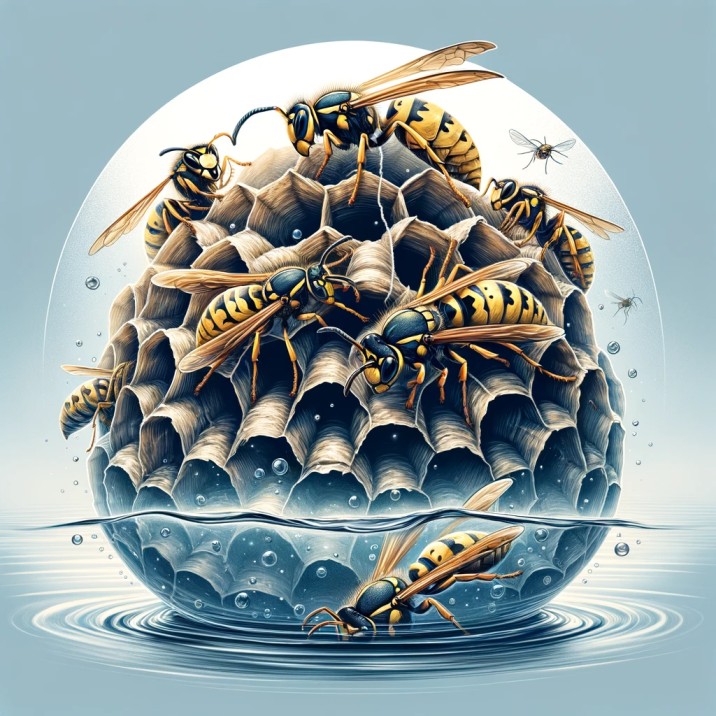We have shared a short answer to Do wasp sleep? The concept of sleep in wasps is a fascinating area of entomological study. Unlike humans and many other animals, wasps do not sleep in the same way we understand it. They do, however, have periods of rest. During these times, wasps are less active and their metabolism slows down, which is somewhat analogous to sleep. Understanding this behavior not only sheds light on the daily rhythms of these insects but also offers insights into their biology and ecology.
The Nature of Wasp Rest

Wasps, like many insects, follow a circadian rhythm, a 24-hour cycle influenced by light and dark. This cycle dictates their periods of activity and rest. During the cooler parts of the day, typically at night, wasps exhibit less activity. This is when they are most likely to be found in a state of rest. They often retreat to their nests or find shelter in crevices or under foliage. During this time, their bodily functions slow down, but it’s not sleep as we know it – their brains do not cycle through phases like REM or deep sleep.
The nature of wasp rest is a subject that intertwines biology, behavior, and environmental adaptation. Unlike mammals, wasps do not experience sleep in the traditional sense; they do not have sleep cycles or stages like REM sleep. Instead, their rest phase is a state of reduced activity and metabolic slowdown, which occurs predominantly during cooler periods, such as nighttime.
During these rest phases, wasps are often found in a state of torpor, a condition where their body temperature, heart rate, and overall metabolic activity decrease. This state allows them to conserve energy, which is crucial for their survival, especially in environments where resources are limited or during seasonal changes. The torpor state in wasps can be observed in their physical stillness, often clinging motionless to structures or nestling in their nests.
The Importance of Rest for Wasps

This resting state is crucial for wasps, as it conserves energy for their more active periods, primarily when foraging or building nests. The energy conservation aspect is particularly vital for their survival, especially in colder climates where food sources become scarce. Additionally, rest periods help wasps maintain their internal biological clocks, ensuring they stay aligned with environmental cycles, which is crucial for their reproductive and social behaviors.
The importance of rest for wasps extends beyond mere energy conservation; it is integral to their survival, physiological health, and social structure. During rest periods, wasps conserve energy needed for high-energy activities like foraging, building, and maintaining nests, and caring for the young. These activities are vital for the survival of both individual wasps and the colony as a whole.
Moreover, rest contributes to the regulation of a wasp’s internal biological processes. It allows for the repair and maintenance of bodily tissues, supports immune function, and helps in managing stress. For social species of wasps, these rest periods are also crucial for maintaining the intricate social dynamics of the colony. The division of labor within a wasp colony is a delicate balance, and rest is key for the effectiveness and efficiency of these roles, whether it be foraging, caring for larvae, or defending the nest. In this way, rest is not just a passive state but an active contributor to the colony’s overall health and success.
Comparing Wasp Rest with Other Insects

Wasps’ rest patterns can be contrasted with other insects. For example, bees, close relatives of wasps, also have periods of rest but are known to exhibit more profound sleep-like states, including the ability to dream. On the other hand, some insects, like certain ant species, have very short and frequent periods of rest, akin to power naps.
Comparing the rest patterns of wasps with other insects reveals fascinating differences in insect behavior and physiology. Bees, for example, exhibit deeper sleep-like states, including the possibility of experiencing something akin to dreaming. Their rest is more pronounced and vital for memory consolidation and learning. On the other end of the spectrum, certain ants exhibit polyphasic sleep patterns, taking brief, frequent naps throughout the day. This adaptation is believed to support their complex social structures and continuous labor needs. In contrast, butterflies and moths, particularly during their caterpillar stage, have long periods of inactivity which are crucial for growth and metamorphosis. These variations underscore the diversity of rest strategies across insect species, each evolved to meet the specific demands of their ecological niches and lifestyles.
Human Perception of Wasps: More Than Just Pests
Often perceived primarily as pests or threats due to their stings, wasps are in fact crucial components of their ecosystems. They are predators of many pest insects, thus playing a role in natural pest control. They also act as pollinators for a variety of plants. Understanding their rest patterns and daily rhythms can help in devising better strategies for managing wasp populations in urban and agricultural settings, balancing the need to mitigate the risks they pose to humans with the ecological benefits they provide.
The Impact of Environmental Changes on Wasp Behavior
Environmental factors, such as changes in temperature and light, have a significant impact on wasp behavior, including their rest periods. Climate change, habitat loss, and light pollution can disrupt their natural cycles, potentially affecting their survival and ecological roles. Studies have shown that altered light patterns can disrupt the circadian rhythms of various insects, including wasps, leading to changes in their activity and rest patterns.
Wasps in Scientific Research
The study of wasp behavior, including their rest patterns, contributes to broader scientific understanding in fields like entomology, ecology, and even robotics. For instance, understanding the flight patterns and nest-building behaviors of wasps has inspired designs in drone technology and architectural concepts. Additionally, their complex social structures provide valuable insights into the study of social behavior in animals.
Conservation and Public Awareness
While wasps are often less favored in conservation efforts compared to bees, they are equally important. Efforts to educate the public about the ecological importance of wasps, alongside strategies to coexist safely with them, are crucial. Simple measures, such as avoiding the destruction of nests in non-threatening situations and promoting wasp-friendly gardening practices, can aid in their conservation.
While wasps do not sleep in the conventional sense, they have distinct periods of rest that are vital for their survival and efficiency. Understanding these patterns is more than an academic pursuit; it has practical implications for ecological balance, pest management, and even technological innovation. Recognizing the significance of wasps beyond their stings, and appreciating their role in the environment, is a step forward in promoting biodiversity and ecological awareness.

